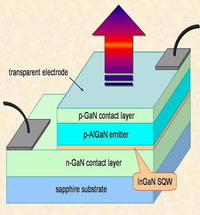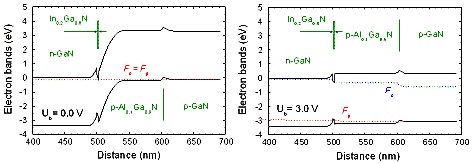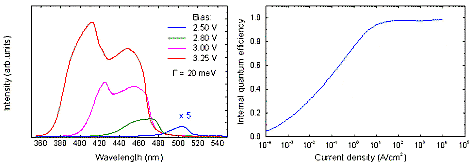Device Modeling. Overview
 Fig.1. Scheme of the LED based on InGaN/GaN
heterostructure. |
Nitride Light Emitting Diodes
Operation of Al-In-Ga-N single-quantum-well or multiple-quantum-well light emitting diodes (LEDs) is considered in terms of 1D drift-diffusion model of carried injection. We provide band diagram of an LED, build-in electric field, distributions of electron and hole concentrations across the structure as well as those of the radiative and non-radiative recombination rates, as a function of bias. I-V characteristic and light emission efficiency is computed to assess the LED structure performance.
 Fig.2. Band diagrams of a SQW-AlGaN/InGaN/GaN
blue LED structure at different forward biases. |
The light emission spectra are found from the coupled solution of the Poisson and Scrodinger equations with account of the complex valence band structure of the nitride.
 Fig.3. Emission spectra at various biases
and light emission efficiency as a function of LED current. |
Models for simulation of nitride LEDs
We use the 1D drift-diffusion model to simulate the nitride LED operation. The model includes the Poisson equation for the electric potential and the continuity equations for the electron and hole currents. Fermi-Dirac statistics is used for both electron and holes. Spontaneous and piezo- polarization important for group-III nitrides is accounted for in the boundary conditions for the Poisson equation. We consider the non-radiative carrier recombination on threading dislocation cores using the original approach [1] relating the recombination rate with the dislocation density.
Coupled solution of the Poisson and Schrodinger equations is used to find the light emission spectra from the LED active region. The Kohn-Luttinger approach is used to consider the complex valence band structure. A uniform broadening of the emission spectra is currently assumed. We plan to account for the In composition fluctuation in the InGaN quantum well in the nearest future.
Software
SiLENSe (Simulator for Light Emitters based on Nitride Semiconductors)—software tool for LED bandgap engineering is offered for modeling band diagrams and characteristics of light emitting diodes (LEDs) based on group-III nitrides. Detailed description of the product and its evaluation version are presented on the SiLENSe page.BESST (Bandgap Engineering Superlattice Simulation Tool)—software package
for device simulation that allows researchers to calculate the key electrical
properties of individual group-III nitride superlattices as well as to simulate
the operation of SL based devices. For more detailes see
the BESST page.
[1] S.Yu.Karpov and Yu.N.Makarov, Appl.Phys.Lett. 81 (2002) 4721.
